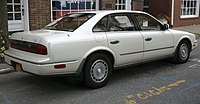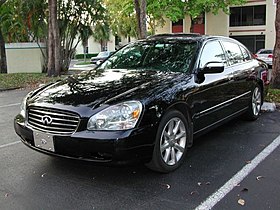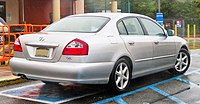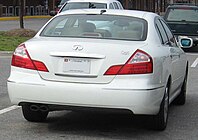
Infiniti is the luxury vehicle division of the Japanese automaker Nissan. Infiniti officially started selling vehicles on November 8, 1989, in North America. The marketing network for Infiniti-branded vehicles included dealers in over 50 countries in the 2010s. As of 2020, there were 25 markets served by new car dealers. The main markets are North America, China, Taiwan, and the Middle East.

The Nissan Maxima is a car manufactured and marketed by Nissan and offered as Nissan's flagship sedan primarily in North America, the Middle East, South Korea, and China—and currently in its eighth generation. Having debuted for model year 1982 as the Datsun Maxima, it replaced the earlier Datsun 810. The name Maxima dates to the 1981 model year when Datsun marketed the upscale 810 as the 810 Maxima in North America. Like the 810, early versions of the Maxima had their origins in the Datsun/Nissan Bluebird. It is renamed to Nissan Maxima when the Datsun brand was phased out for the 1985 model year.

The Nissan Pathfinder is a range of sport utility vehicles manufactured by Nissan since 1986. Until the third-generation model, the Pathfinder is based on Nissan's compact pickup truck platform which it shares with the Navara/Frontier. The front end of the D21 and R51 Pathfinder is notably identical with the Navara/Frontier up until the B-pillars.

The Infiniti J30, marketed as the Nissan Leopard J Ferie in Japan, was a rear wheel drive luxury car. The J30 went into production on April 7, 1992 as a 1993 model to replace the M30, and was launched in the United States after its competitors, the Lexus GS and Acura Legend. The car was sold in the mid-size sedan segment between the smaller G20 and the larger Q45, both by size and price. The small interior resulted from its rounded styling uncharacteristic of the crowded executive car class, which is now considered an early variant of a four-door coupé.
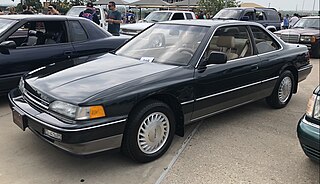
The Acura Legend is a mid-size luxury car manufactured by Honda from Japan. It was sold in the U.S. and Canada under Honda's luxury brand, Acura, from 1985 until 1995. It was the first flagship sedan sold under the Acura nameplate, until being renamed in 1996 as the Acura 3.5RL. The 3.5RL was the North American version of the KA9 series Honda Legend.
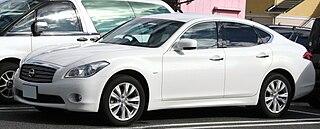
The Nissan Fuga is a mid-size luxury sedan produced by Japanese automaker Nissan since October 2004. It is built on a wider, stretched wheelbase version of the Nissan FM platform. After the Nissan Cima and Nissan President were discontinued in August 2010, the Fuga became Nissan's flagship vehicle. In North America and Europe, the Fuga was sold as the second and third-generation Infiniti M and Infiniti Q70, where it was the flagship sedan of the Infiniti luxury division of Nissan from 2006 to 2019.

The Infiniti M is a line of mid-size luxury (executive) cars from the Infiniti luxury division of Nissan. From 2013 on it has been marketed as the Infiniti Q70, reflecting the company's new naming scheme.

The Nissan Cefiro is a mid-size passenger car manufactured and marketed by Nissan Motors over three generations. Almost all Cefiro's were marketed as four-door sedans, though a five-door wagon body style was briefly available (1997–2000). In most cases, the Cefiro used Nissan's VQ six-cylinder engines, named Ward's 10 Best Engines more than ten years running.

The Honda Legend is a series of V6-engined executive cars that was produced by Honda between 1985 and 2021, and served as its flagship vehicle. The Legend has also been sold under the Acura Legend, RL and RLX nameplates — the successive flagship vehicles of Honda's luxury Acura division in North America from 1986 until 2020.

The Nissan Laurel is a two- and four-door sedan manufactured and marketed by Nissan from 1968 to 2002. Later generations added all-wheel-drive along with turbocharged engines. Introduced in 1968 as a new model positioned above the Datsun Bluebird 510, the Laurel offered the luxury of the Nissan Gloria A30 in a shorter wheelbase, and has always been the luxury version of the Skyline range for all generations, sharing engines, suspensions and handling dynamics of the popular performance coupe and sedan while having a longer wheelbase.

The Gloria is a large luxury car made from 1959 by the Prince Motor Company, and later by Nissan Motors since its merger with the former - hence being originally marketed as Prince Gloria and later as Nissan Gloria. Initially based on the smaller Prince Skyline, the Gloria line was merged with Nissan Cedric starting with 1971 models and both continued until 2004, when they were both replaced by Nissan Fuga.

The Nissan Cedric is a large automobile produced by Nissan from 1960 to 2015. It was developed to provide upscale transportation, competing with the Prince Skyline and Gloria which were later merged into the Nissan family. In later years, the Nissan Skyline was positioned as a sports sedan/coupe, whereas the Nissan Gloria was turned into a sporty version of the Cedric.

The Nissan President is a Japanese luxury sedan that was manufactured and marketed by Nissan from 1965 until 2010 as the flagship of Nissan's range, available only at its Nissan Store dealerships then at Nissan Blue Stage dealerships.

The Nissan Cima is a luxury sedan manufactured and marketed by Nissan for the Japanese market. The name Cima is derived from Spanish for "summit". Earlier generations featured a hood ornament with an image of an acanthus leaf that was the naming basis for the Nissan Laurel. The acanthus leaf was commonly used by classical Greeks to make a wreath for use as a crown.
HICAS is Nissan's rear wheel steering system which was fitted to cars from approximately 1985 to 2010, including models ranging from the Skyline and Fairlady Z (Z32) to smaller vehicles like the Nissan Cefiro (A31), Silvia /240SX/180SX and Nissan Serena/Nissan Largo. It is also found on models from the Infiniti division, such as the Q45, J30, M45/M35 and G35/G37.

The Infiniti G Line is a series of compact executive cars manufactured and marketed by Infiniti, a luxury division of Nissan, for the 1991–1996 and 1999–2016 model years — across four generations.
ATTESA is a four-wheel drive system used in some automobiles produced by the Japanese automaker Nissan, including some models under its luxury marque Infiniti.

The Nissan Leopard is a line of sport/luxury cars built by Japanese carmaker Nissan. The Leopard began life in 1980 and was discontinued in 1999. The Leopard were initially based on the Japanese market Nissan Skyline and Nissan Laurel, then later based on the chassis of their Nissan Cedric and Nissan Gloria contemporaries and were rear wheel drive. Final versions were the contributing factors to Nissan's Infiniti M and J products.

The Mitsubishi Dignity is a full-size luxury car originally manufactured by Mitsubishi Motors from late 1999 to 2001 as the flagship of the company's domestic range, alongside the shorter Proudia, and was reintroduced 2012 to Japanese buyers as a rebadged fifth-generation Nissan Cima. The Dignity was discontinued for the second time in 2016. In Japan, it was sold at a specific retail chain called Galant Shop.

The Infiniti QX80 is a full-size luxury SUV marketed by Nissan's luxury division Infiniti. The first-generation QX56 was built in the United States and is based on the first-generation Armada. The second-generation model was released in 2010 as a model produced in Japan, which used the sixth-generation Patrol as the base vehicle instead. Since the 2014 model year in 2013, the vehicle was renamed to the QX80 as Infiniti renamed their entire product line under a new nomenclature.



